Turbo-Roundabouts as an Instrument for Improving the Efficiency and Safety in Urban Area: An Italian Case Study
Abstract
:1. Introduction
2. Literature Review
- macroscopic; treat stationary and aggregated values,
- mesoscopic; study the temporal evolution of all the variables and,
- microscopic; intermediate level between the two previously-mentioned levels.
- VISSIM, developed by Planung Transport Verkehr (PTV), a German company, is a microscopic simulation program for modeling multimodal transport operations. VISSIM is characterized by a discrete, stochastic, and time step-based model in which vehicle units are represented as individual entities.
- AIMSUN Next, developed by Siemens (one of the largest manufacturers of signal control systems), is capable of generating various traffic conditions based on either stochastic route choice or dynamic user equilibrium.
- PARAMICS, developed by Quadstone Limited, a Scottish company, is a software for modeling the movement and behavior of individual vehicles and transit on local and regional freeway networks.
- TRITONE, developed by University of Calabria, is an open-source platform that also allows the evaluation of traffic safety performance through a set of indicators that represent the interactions in real time between different pairs of vehicles of the traffic flow.
3. Materials and Methods
3.1. Site Selection
3.2. Traffic Scenarios
- Scenario n. 1: Q1 = 4594 vehicles/hour
- Scenario n. 2: Q2 = 4977 vehicles/hour
- Scenario n. 3: Q3 = 5359 vehicles/hour
- Scenario n. 4: Q4 = 5742 vehicles/hour
3.3. Micro-Simulation Process
- (1)
- AIMSUN Next for the calculation of the operational performance corresponding to the traffic scenarios described in the previous paragraph;
- (2)
- SSAM for the estimation of the safety indicators, starting from the kinematic parameters associated with all the vehicle trajectories obtained as output of the AIMSUN Next software.
3.3.1. AIMSUN Model
- (1)
- geometric scheme of the road network.
- (2)
- modelling of vehicle behavior.
- Centroids. They are the source of vehicles entering and exiting the network.
- Nodes (intersections). They are treated as node servers in the mesoscopic representation. In the node servers, vehicles are directed from one section to a turning and then to their next section. These turnings connect the lanes of the originating section to the lanes of the destination section. All vehicles are assumed to travel unimpeded, i.e., at free-flow speed, in turnings.
- Edges. They are the segments that connect the nodes. Each edge contains information about its geometry (e.g., the number of lanes, shoulder width, etc.).
- The behavioral models used in AIMSUN are the following:
- Behavioral models in edges: Car-following models and lane-changing models.
- Behavioral models in nodes (intersections): Gap acceptance and lane choice models.
- -
- t = simulation time;
- -
- n = vehicle number ordered by its arrival time on the lane;
- -
- x(t, n) = position of vehicle n at time t;
- -
- Sn = speed of the nth vehicle;
- -
- Sn(max) = maximum speed of the vehicle (the minimum between the desired maximum speed of the vehicle and the maximum speed of the edge);
- -
- EL = effective length of the vehicle (vehicle length plus minimum distance between vehicles);
- -
- d = distance between the vehicles;
- -
- RT = reaction time of the driver of the follower vehicle;
- -
- dc = maximum deceleration of the considered vehicle;
- -
- dc(e) = estimate of the desired deceleration of the leading vehicle;
- -
- d = distance between the vehicles.
- (1)
- Total number of stops: A stop for a vehicle happens whenever its speed decreases below the queue entry speed and while it remains below the queue exit speed parameter. Once the vehicle speed goes above the queue exit speed parameter the vehicle is no longer considered in a queue nor stopped. A new stop will be added to the number of stops statistics when the vehicle speed goes below queue entry speed again.
- (2)
- Delay Time: Average delay time per vehicle per kilometer (seconds/km). This is the difference between the expected travel time (the time it would take to traverse the system under ideal conditions) and the travel time. It is calculated as the average of all vehicles and then converted into time per kilometer. It does not include the time spent in a virtual queue.
3.3.2. SSAM Model
- -
- The Dimension class contains information about the spatial characteristics of the rectangular bounding box of the microsimulation environment.
- -
- The Timestep class contains a record of the current time step since the start of the simulation. This variable allows SSAM to position the vehicles in time.
- -
- The Vehicle class contains information about the spatial characteristics of the vehicle and the speed and acceleration values used to predict vehicle motion.
- -
- The Conflict class contains information about the conflict angle, which is an approximate angle for a hypothetical collision between colliding vehicles based on the estimated heading of each vehicle. Depending on the values of this angle, the resulting conflict may be a rear-end collision, a lane change, or crossing movement. Specifically, the rear-end angle is used to define a potential collision when following and lane changing, and the crossing angle defines potential collisions in head-on scenarios, such as maneuvering through an intersection (Figure 6).
- Maximum speed (MaxS)— the maximum speed (m/s) of two vehicles involved in the conflict event [64].
- Difference in vehicle speeds (DeltaS)—the absolute value of difference in speeds (m/s) of two conflicting vehicles [64].
- Initial Deceleration Rate (DR)—the magnitude of the deceleration action (m/s2) of a driver the moment he begins an evasive braking maneuver [65].
- Maximum deceleration rate (MaxD)—the maximum deceleration (m/s2) of the through vehicle [45].
4. Results and Discussion
- ➢
- Crossing conflicts: These types of conflicts almost cancel out in the turbo-roundabout configuration compared to the multi-lane roundabout configuration. It should be noted, however, that the percentage of these conflicts, as could logically be expected in a context where the two main intersections are roundabouts, is already low in each of the scenarios considered. Therefore, it is not considered appropriate to highlight this result.
- ➢
- Rear End Conflicts: Although this type of conflict generally has the least severe consequences, it is the most common in all of the traffic scenarios considered. In scenarios n. 3 and n. 4, which refer to the road configuration characterized by the presence of multi-lane roundabouts, the number of conflicts even exceeds 8000 on average. The presence of turbo-roundabouts drastically reduces these conflicts, especially in configurations with high traffic volumes: −38% (scenario n. 1), −42% (scenario n. 2), −68% (scenario n. 3), −69% (scenario n. 4).
- ➢
- Lane change Conflicts: The two multi-lane roundabouts have two lanes on the circulatory roadway. It was logical to expect that the simulations would yield a large number of lane change conflicts; nearly 450 in scenario n. 1, about 700 in scenario n. 2, and over 1200 in both scenario n. 3 and scenario n. 4. The design of turbo-roundabouts would result in a very significant reduction in these conflicts. This is confirmed by the following reductions identified in the simulations: −75% (scenario n. 1), −78% (scenario n. 2), −86% (scenario n. 3) and −86% (scenario n. 4).
5. Conclusions
Author Contributions
Funding
Institutional Review Board Statement
Informed Consent Statement
Data Availability Statement
Conflicts of Interest
References
- Rella Riccardi, M.; Augeri, M.G.; Galante, F.; Mauriello, F.; Nicolosi, V.; Montella, A. Safety Index for evaluation of urban roundabouts. Acc. Anal. Prev. 2022, 158, 106858. [Google Scholar] [CrossRef] [PubMed]
- Leonardi, S.; Distefano, N.; Pulvirenti, G. Italians’ public opinion on road roundabouts: A web based survey. Transp. Res. Proc. 2020, 45, 293–300. [Google Scholar] [CrossRef]
- Distefano, N.; Leonardi, S.; Consoli, F. Drivers’ Preferences for Road Roundabouts: A Study based on Stated Preference Survey in Italy. KSCE J. Civ. Eng. 2019, 23, 4864–4874. [Google Scholar] [CrossRef]
- Distefano, N.; Leonardi, S. Experimental investigation of the effect of roundabouts on noise emission level from motor vehicles. Noise Control Eng. J. 2019, 67, 282–294. [Google Scholar] [CrossRef]
- Ignaccolo, M.; Zampino, S.; Maternini, G.; Tiboni, M.; Leonardi, S.; Inturri, G.; Le Pira, M.; Cocuzza, E.; Distefano, N.; Giuffrida, N.; et al. How to redesign urbanized arterial roads? The case of Italian small cities. Transp. Res. Proc. 2022, 60, 196–203. [Google Scholar] [CrossRef]
- Tollazzi, T. Alternative Types of Roundabouts: An Informational Guide; Springer International Publishing: New York, NY, USA, 2015. [Google Scholar]
- Elhassy, Z.; Abou-Senna, H.; Radwan, E. Performance evaluation of basic turbo roundabouts as an alternative to conventional double-lane roundabouts. Transp. Res. Rec. 2021, 2675, 180–193. [Google Scholar] [CrossRef]
- Balado, J.; Díaz-Vilarino, L.; Arias, P.; Novo, A. A safety analysis of roundabouts and turbo roundabouts based on Petri nets. Traffic Inj. Prev. 2019, 20, 400–405. [Google Scholar] [CrossRef]
- Ciampa, D.; Diomedi, M.; Giglio, F.; Olita, S.; Petruccelli, U.; Restaino, C. Effectiveness of unconventional roundabouts in the design of suburban intersections. Eur. Transp. /Trasp. Eur. 2020, 80, 1–16. [Google Scholar] [CrossRef]
- Mauro, R.; Cattani, M.; Guerrieri, M. Evaluation of the Safety Performance of Turbo Roundabouts by Means of a Potential Accident Rate Mode. Balt. J. Road Bridge Eng. 2015, 10, 28–38. [Google Scholar] [CrossRef]
- Petru, J.; Krivda, V. An Analysis of Turbo Roundabouts from the Perspective of Sustainability of Road Transportation. Sustainability 2021, 13, 2119. [Google Scholar] [CrossRef]
- Pitlova, E.; Kocianova, A. Case Study: Capacity Characteristics Comparison of Single-lane Roundabout and Turbo-roundabouts. Procedia Eng. 2017, 192, 701–706. [Google Scholar] [CrossRef]
- Šarić, A.; Lovrić, I. Multi-Lane Roundabout Capacity Evaluation. Front. Built Environ. 2017, 3, 42. [Google Scholar] [CrossRef]
- Someswara, R.B.; Kadali, B.R. Review Of Traffic Safety Evaluation At T-intersections Using Surrogate Safety Measures In Developing Countries Context. IATSS Res. 2022, 3, 307–321. [Google Scholar] [CrossRef]
- Sobhani, A.; Young, W.; Sarvi, M. A simulation based approach to assess the safety performance of road locations. Transp. Res. Part C Emerg. Technol. 2013, 32, 144–158. [Google Scholar] [CrossRef]
- Young, W.; Sobhani, A.; Lenne, M.G.; Sarvi, M. Simulation of safety: A review of the state of the art in road safety simulation modelling. Accid. Anal. Prev. 2014, 66, 89–103. [Google Scholar] [CrossRef]
- Killi, D.V.; Vedagiri, P. Proactive evaluation of traffic safety at an unsignalized intersection using Microsimulation. J. Traffic Logist. Eng. 2014, 2, 140–145. [Google Scholar] [CrossRef]
- Essa, M.; Sayed, T. Simulated traffic conflicts: Do they accurately represent field- measured conflicts? Transp. Res. Rec. 2015, 2514, 48–57. [Google Scholar] [CrossRef]
- Mahmud, S.M.S.; Ferreira, L.; Hoque, M.S.; Tavassoli, A. Micro-simulation modelling for traffic safety: A review and potential application to heterogeneous traffic environment. IATSS Res. 2019, 43, 27–36. [Google Scholar] [CrossRef]
- Ulak, M.B.; Ozguven, E.E.; Moses, R.; Sando, T.; Boot, W.; Abdel Razig, Y.; Sobanjo, J.O. Assessment of traffic performance measures and safety based on driver age and experience: A microsimulation based analysis for an unsignalized T-intersection. J. Traffic Transp. Eng. 2019, 6, 455–469. [Google Scholar] [CrossRef]
- Guo, Y.; Sayed, T.; Zheng, L.; Essa, M. An extreme value theory based approach for calibration of microsimulation models for safety analysis. Simul. Model. Pract. Theory. 2021, 106, 102172. [Google Scholar] [CrossRef]
- Torday, A.; Baumann, D.; Dumont, D. Indicator for microsimulation-based safety evaluation. In Proceedings of the 3rd STRC Swiss Transport Research, Monte, Verita, 19–21 March 2003. [Google Scholar]
- Caliendo, D.; Guida, M. Microsimulation approach for predicting crashes at unsignalized intersections using traffic conflicts. J. Transp. Eng. 2012, 138, 1453–1467. [Google Scholar] [CrossRef]
- Astarita, V.; Festa, D.C.; Giofrè, V.P.; Guido, G. Surrogate safety measures from traffic simulation models a comparison of different models for intersection safety evaluation. Transp. Res. Proc. 2019, 37, 219–226. [Google Scholar] [CrossRef]
- Ozbay, K.; Yang, H.; Bartin, B.; Mudigonda, S. Derivation and validation of new simulation-based surrogate safety measure. Transp. Res. Rec. 2008, 2083, 105–113. [Google Scholar] [CrossRef]
- Ambros, J.; Turek, R.; Paukrt, J. Road safety evaluation using traffic conflicts: Pilot comparison of micro-simulation and observation. In Proceedings of the International Conference on Traffic and Transport Engineering, Belgrade, Serbia, 27–28 November 2014. [Google Scholar]
- Guido, G.; Astarita, V.; Giofré, V.; Vitale, A. Safety performance measures: A comparison between microsimulation and observational data. Procedia Soc. Behav. Sci. 2011, 20, 217–225. [Google Scholar] [CrossRef]
- Astarita, V.; Guido, G.; Vitale, A.; Giofré, V. A new microsimulation model for the evaluation of traffic safety performances. Eur. Transp. /Trasp. Eur. 2012, 51, 1–16. [Google Scholar]
- Astarita, V.; Giofré, V.; Guido, G.; Vitale, A. Calibration of a new microsimulation package for the evaluation of traffic safety performances. Procedia Soc. Behav. Sci. 2012, 54, 1019–1026. [Google Scholar] [CrossRef]
- Silva, A.; Vasconcelos, L.; Santos, S. Moving from Conventional Roundabouts to Turbo-Roundabouts. Procedia Soc. Behav. Sci. 2014, 111, 137–146. [Google Scholar] [CrossRef]
- Mauro, R.; Branco, F. Comparative Analysis of Compact Multilane Roundabouts and Turbo-Roundabouts. J. Transp. Eng. 2010, 136, 316–322. [Google Scholar] [CrossRef]
- Bulla, L.; Castro, W. Analysis and Comparison between Two-Lane Roundabouts and Turbo Roundabouts Based on a Road Safety Audit Methodology and Microsimulation: A Case Study in Urban Area. In Proceedings of the 3rd International Conference on Road Safety and Simulation, Indianapolis, IN, USA, 14–16 September 2011; Available online: http://onlinepubs.trb.org/onlinepubs/conferences/2011/RSS/2/Bulla,L.pdf (accessed on 14 April 2022).
- Silva, A.; Santos, S.; Gaspar, M. Turbo-Roundabout Use and Design. In Proceedings of the CITTA 6th Annual Conference on Planning Research, Responsive Transports for Smart Mobility, Coimbra, Portugal, 17 May 2013. [Google Scholar]
- Engelsman, J.; Uken, M. Turbo Roundabouts as an Alternative to Two Lane Roundabouts. In Proceedings of the 26th Southern African Transport Conference (SATC 2007), Pretoria, South Africa, 9–12 July 2007; pp. 581–589. Available online: http://www.lags.corep.it/doc/turbo-roundabout.pdf (accessed on 21 April 2022).
- Giuffrè, O.; Guerrieri, M.; Granà, A. Evaluating Capacity and Efficiency of Turbo-Roundabouts. In Proceedings of the 88th Annual Meeting of the Transportation Research Board, Washington, DC, USA, 11–15 January 2009. [Google Scholar]
- Vasconcelos, L.; Silva, A.; Seco, A. Capacity of Normal and Turbo-Roundabouts: Comparative Analysis. Proc. Inst. Civ. Eng. Transp. 2014, 167, 88–99. [Google Scholar] [CrossRef]
- Vasconcelos, L.; Silva, A.B.; Seco, Á.M.; Fernandes, P.; Coelho, M.C. Turboroundabouts: Multicriterion Assessment of Intersection Capacity, Safety, and Emissions. Transp. Res. Rec. J. Transp. Res. Board. 2014, 2402, 28–37. [Google Scholar] [CrossRef]
- Tollazzi, T.; Mauro, R.; Guerrieri, M.; Rençelj, M. Comparative analysis of four new alternative types of roundabouts: Turbo, flower, target and four-flyover roundabout. Period. Polytech. Civ. Eng. 2016, 60, 51–60. [Google Scholar] [CrossRef]
- Silva, A.B.; Mariano, P.; Silva, J.P. Performance assessment of turbo-roundabouts in corridors. Transp. Res. Procedia 2015, 10, 124–133. [Google Scholar] [CrossRef]
- Kwakwa, O.; Adams, C. Assessment of Turbo and Multilane Roundabout Alternatives to Improve Capacity and Delay at a Single Lane Roundabout Using Microsimulation Model Vissim: A Case Study in Ghana. Am. J. Civ. Eng. Archit. 2016, 4, 106–116. [Google Scholar] [CrossRef]
- Gallelli, V.; Iuele, T.; Vaiana, R. Conversion of a Semi-two Lanes Roundabout into a Turbo-Roundabout: A Performance Comparison. Procedia Comput. Sci. 2016, 83, 393–400. [Google Scholar] [CrossRef]
- Giuffrè, O.; Granà, A.; Marino, S. Comparing performances of turbo-roundabouts and double-lane roundabouts. Mod. Appl. Sci. 2012, 6, 70–79. [Google Scholar] [CrossRef]
- Giuffrè, O.; Granà, A.; Marino, S. Turbo-Roundabouts vs Roundabouts Performance Level. Procedia Soc. Behav. Sci. 2012, 53, 590–600. [Google Scholar] [CrossRef]
- Fernandes, P.; Salamati, K.; Rouphail, N.M.; Coelho, M.C. The effect of a roundabout corridor’s design on selecting the optimal crosswalk location: A multi-objective impact analysis. Int. J. Sustain. Transp. 2017, 11, 206–220. [Google Scholar] [CrossRef]
- Gettmann, D.; Pu, L.; Sayed, T.; Shelby, S. Surrogate Safety Assessment Model and Validation: Final Report; United States. Federal Highway Administration. Office of Safety Research and Development: McLean, VA, USA, 2008. Available online: http://www.fhwa.dot.gov/publications/research/safety/08051/08051.pdf (accessed on 28 April 2022).
- Huang, S.; Guo, L.; Yang, Y.; Casas, I.; Sadek, A.W. Dynamic demand estimation and microscopic traffic simulation of a university campus transportation network. Transp. Plan. Technol. 2012, 35, 449–467. [Google Scholar] [CrossRef]
- So, J.; Hoffmann, S.; Lee, J.; Busch, F.; Choi, K. A prediction accuracy-practicality tradeoff analysis of the state-of-the-art safety performance assessment methods. Transp. Res. Proc. 2016, 15, 794–805. [Google Scholar] [CrossRef]
- Al-Ghandour, M.; Schroeder, B.; Williams, B.; Rasdorf, W. Conflict models for single-lane roundabout slip lanes from microsimulation. Transp. Res. Rec. 2011, 2236, 92–101. [Google Scholar] [CrossRef]
- Chai, C.; Wong, Y.D. Micro-simulation of vehicle conflicts involving right-turn vehicles at signalized intersections based on cellular automata. Accid. Anal. Prev. 2014, 63, 94–103. [Google Scholar] [CrossRef] [PubMed]
- Dijkstra, A.; Marchesini, P.; Bijleveld, F.; Kars, V.; Drolenga, H.; van Maarseveen, M. Do calculated conflicts in micro-simulation model predict number of crashes? Transp. Res. Rec. 2010, 2147, 105–112. [Google Scholar] [CrossRef]
- Vasconcelos, L.; Neto, L.; Seco, A.; Silva, A. Validation of the surrogate safety assessment model for assessment of intersection safety. Transp. Res. Rec. 2014, 2432, 1–9. [Google Scholar] [CrossRef]
- Vasconcelos, L.; Silva, A.; Seco, A. Safety analysis of turbo-roundabouts using the SSAM technique. In Proceedings of the CITTA 6th Annual Conference on Planning Research, Coimbra, Portugal, 17 May 2013. [Google Scholar]
- Bulla-Cruz, L.; Lyons, L.; Darghan, E. Complete-Linkage Clustering Analysis of Surrogate Measures for Road Safety Assessment in Roundabouts. Rev. Colomb. Estad. 2021, 44, 91–121. [Google Scholar] [CrossRef]
- Chen, Y.; Persaud, B.; Lyon, C. Effect of Speed on Roundabout Safety Performance: Implications for Use of Speed as Surrogate Measure. In Proceedings of the Transportation Research Board 90th Annual Meeting, TRID, Washington, DC, USA, 23–27 January 2011. [Google Scholar]
- Džambas, T.; Ahac, S.; Dragčević, V. Design of turbo roundabouts based on the rules of vehicle movement geometry. J. Transp. Eng. 2016, 142, 05016004. [Google Scholar] [CrossRef]
- CROW. Turborotondes; CROW Publication no.257. Ede; CROW: Dutch, The Netherlands, 2008. [Google Scholar]
- Ciuffo, B.; Casas, J.; Montanino, M.; Perarnau, J.; Punzo, V. Gaussian process metamodels for sensitivity analysis of traffic simulation models: Case study of AIMSUN mesoscopic model. Transp. Res. Rec. 2013, 2390, 87–98. [Google Scholar] [CrossRef]
- Virdi, N.; Grzybowska, H.; Waller, S.T.; Dixit, V. A safety assessment of mixed fleets with connected and autonomous vehicles using the surrogate safety assessment module. Accid. Anal. Prev. 2019, 131, 95–111. [Google Scholar] [CrossRef]
- Pu, L.; Joshi, R. Surrogate Safety Assessment Model (SSAM)—Software User Manual. Federal Highway Administration, Virginia, 2008. Available online: https://www.fhwa.dot.gov/publications/research/safety/08050/08050.pdf (accessed on 4 March 2022).
- Guo, Y.; Essa, M.; Sayed, T.; Haque, M.M.; Washington, S. A Comparison between Simulated and Field-Measured Conflicts for Safety Assessment of Signalized Intersections in Australia. Transp. Res. Part C Emerg. Technol. 2019, 101, 96–110. [Google Scholar] [CrossRef]
- Hayward, J.C. Near-miss determination through use of a scale of danger. Highw. Res. Rec. 1972, 1, 24–34. Available online: http://onlinepubs.trb.org/Onlinepubs/hrr/1972/384/384-004.pdf (accessed on 4 February 2022).
- Pulvirenti, G.; De Ceunynck, T.; Daniels, S.; Distefano, N.; Leonardi, S. Safety of bicyclists in roundabouts with mixed traffic: Video analyses of behavioural and surrogate safety indicators. Transp. Res. Part F. Traffic Psychol. Behav. 2021, 76, 72–91. [Google Scholar] [CrossRef]
- Laureshyn, A. In Search of the Severity Dimension of Traffic Events: Extended Delta-v as a Traffic Conflict Indicators. Accid. Anal. Prev. 2017, 98, 46–56. [Google Scholar] [CrossRef] [PubMed]
- Gettman, D.; Head, L. Surrogate safety measures from traffic simulation models. Transp. Res. Record 2003, 1840, 104–115. [Google Scholar] [CrossRef] [Green Version]
- Johnsson, C.; Laureshyn, A.; De Ceunynck, T. In search of surrogate safety indicators for vulnerable road users: A review of surrogate safety indicators. Transp. Rev. 2018, 38, 765–785. [Google Scholar] [CrossRef]
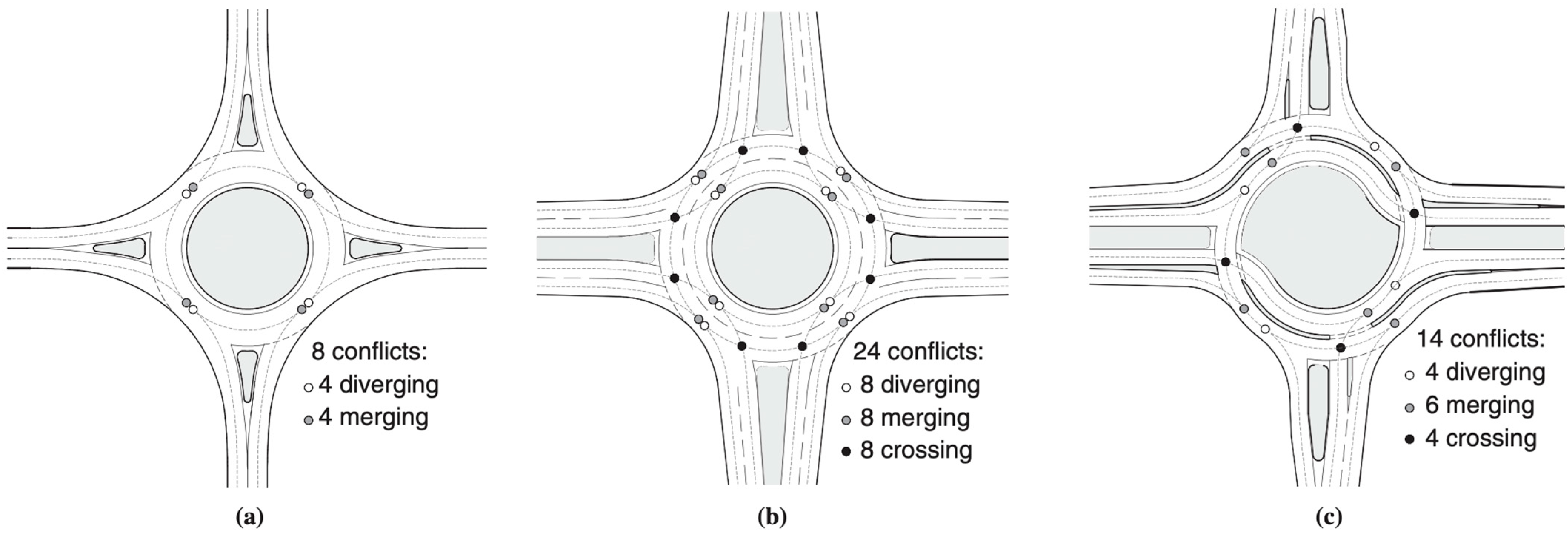

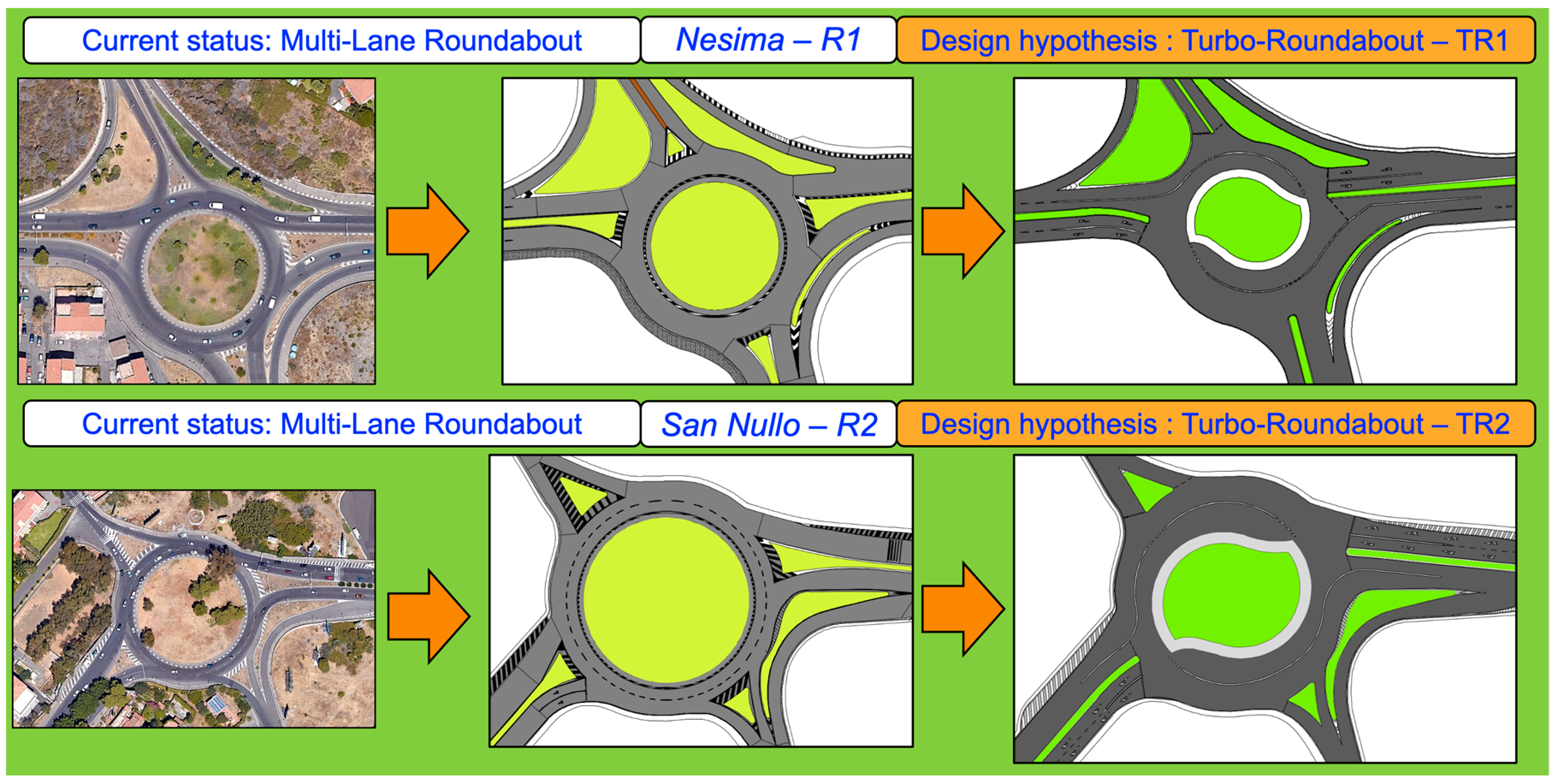
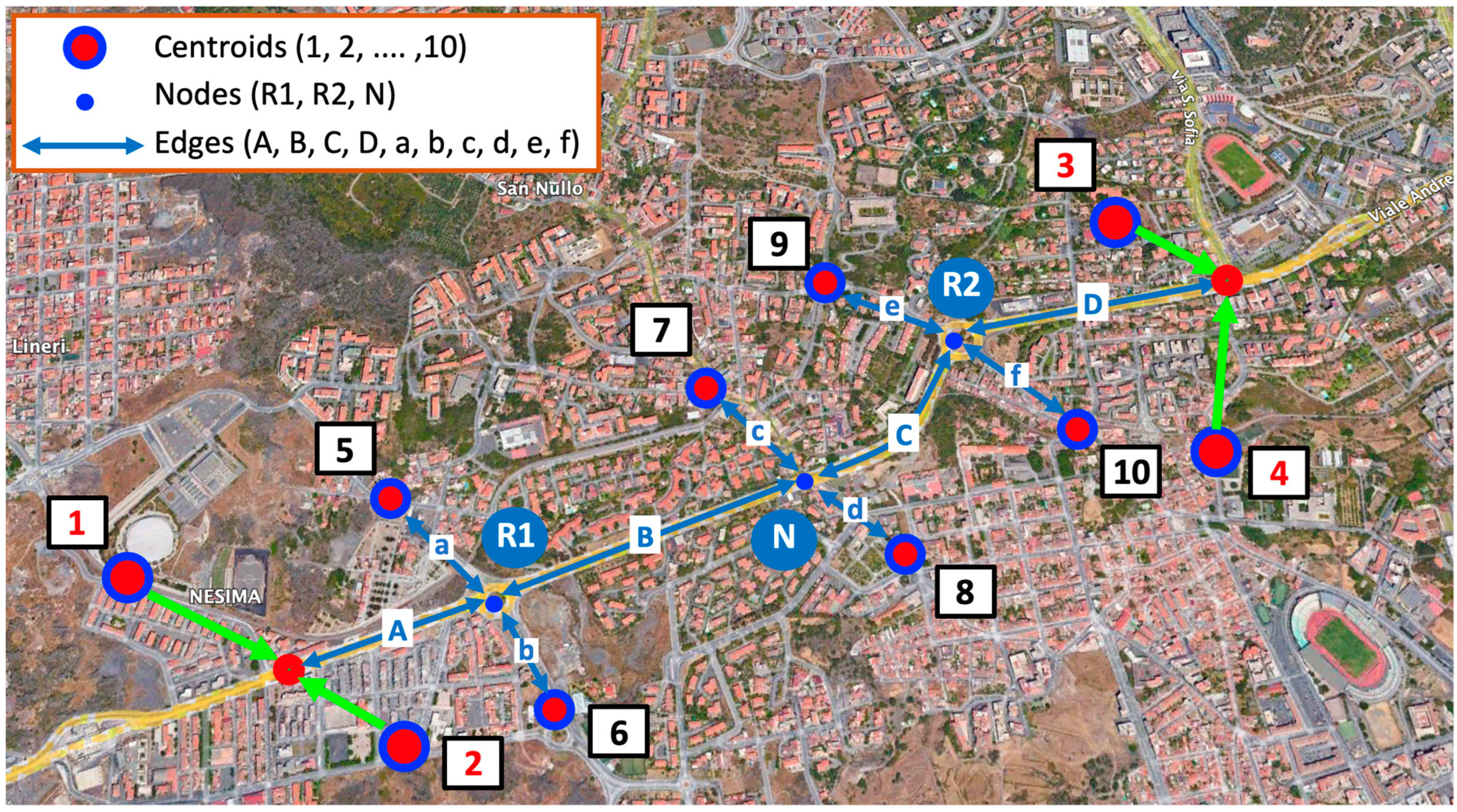
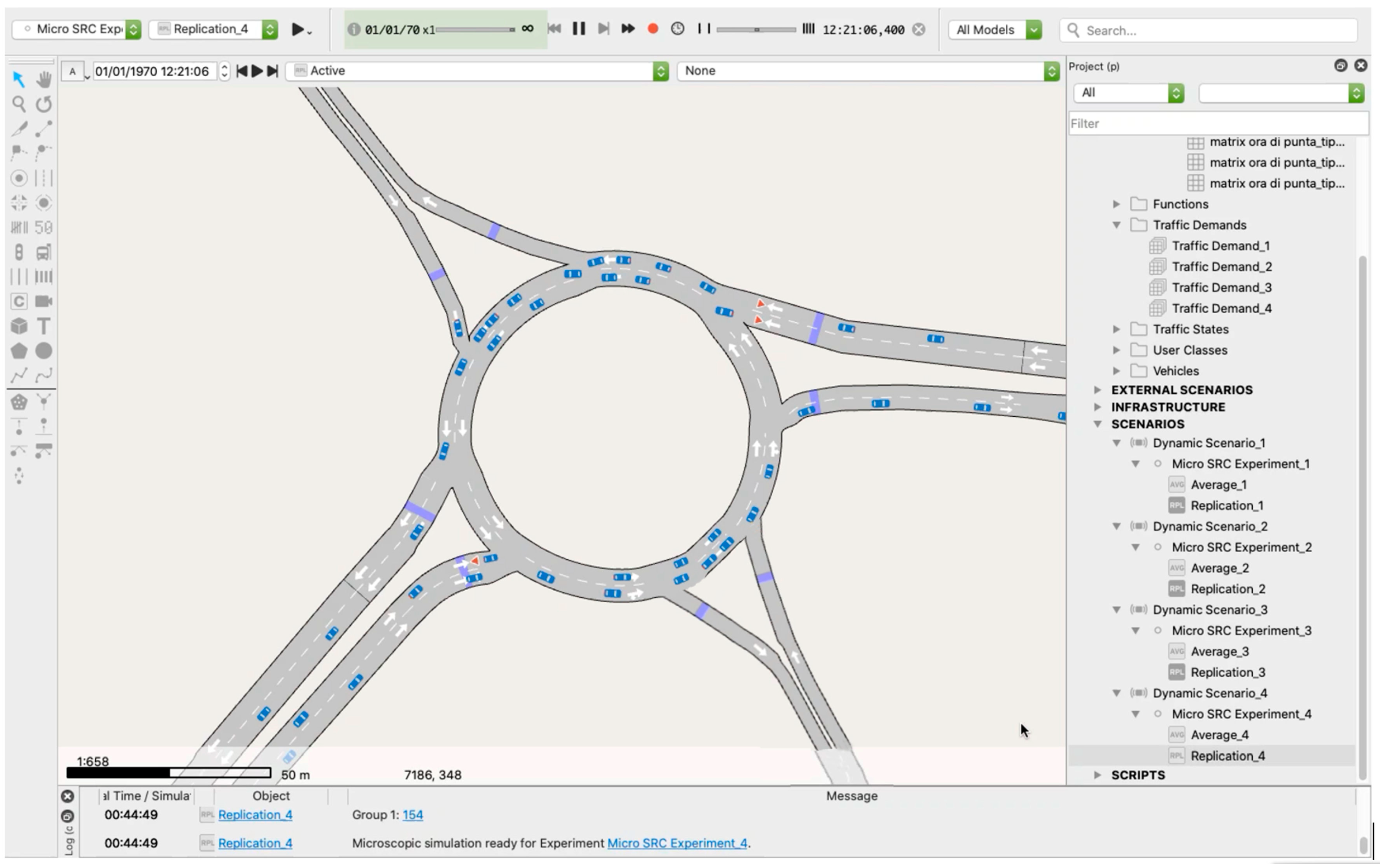
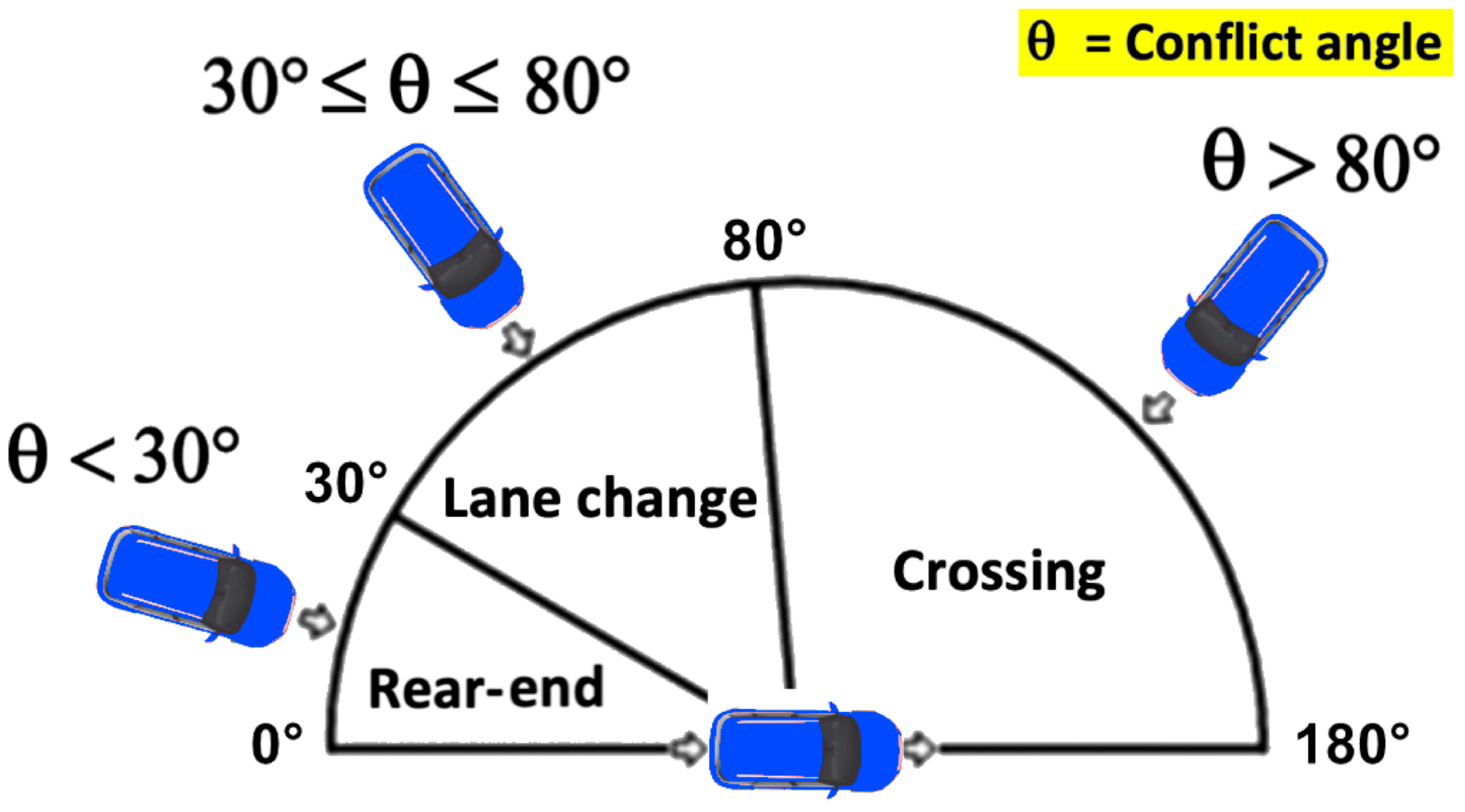
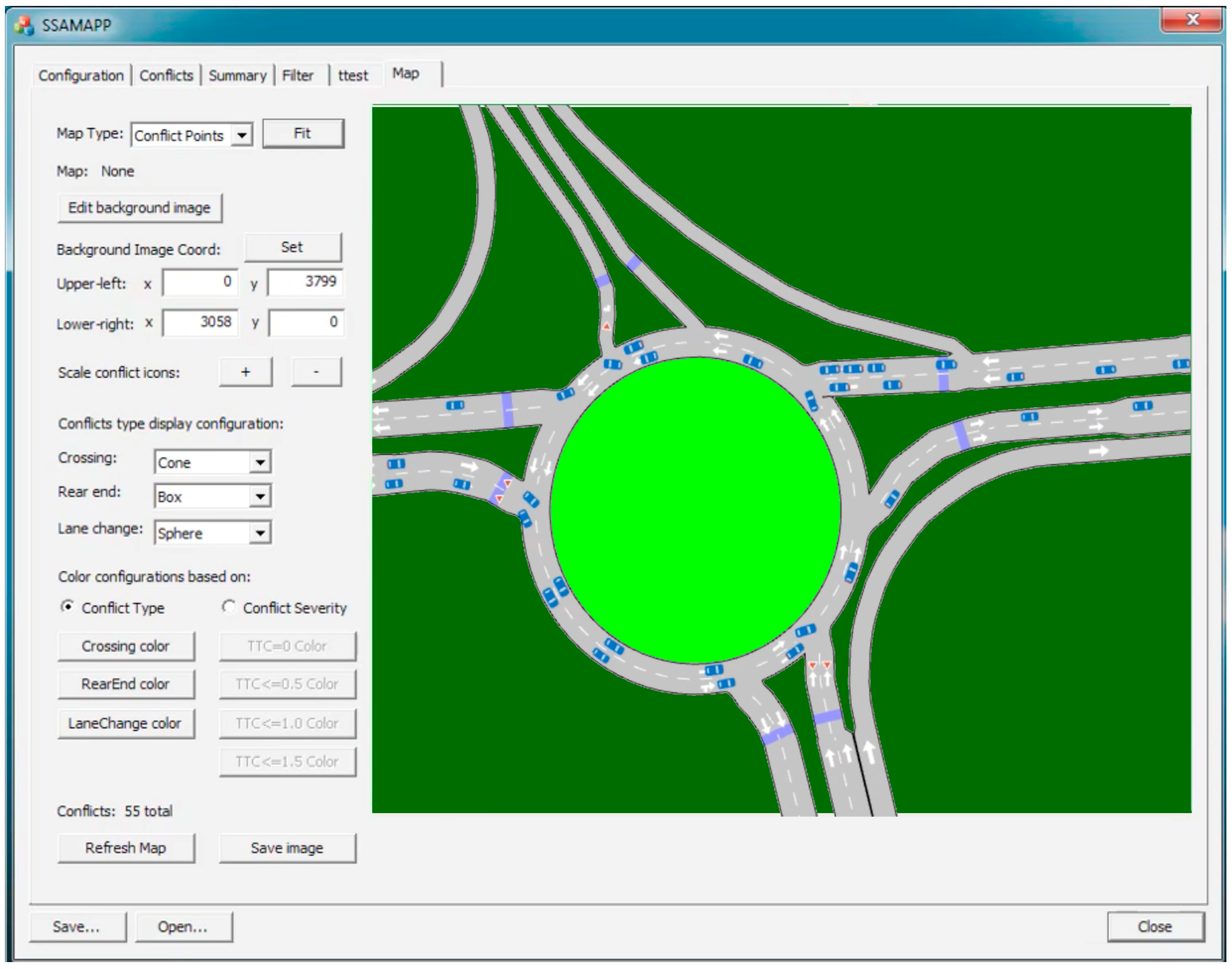
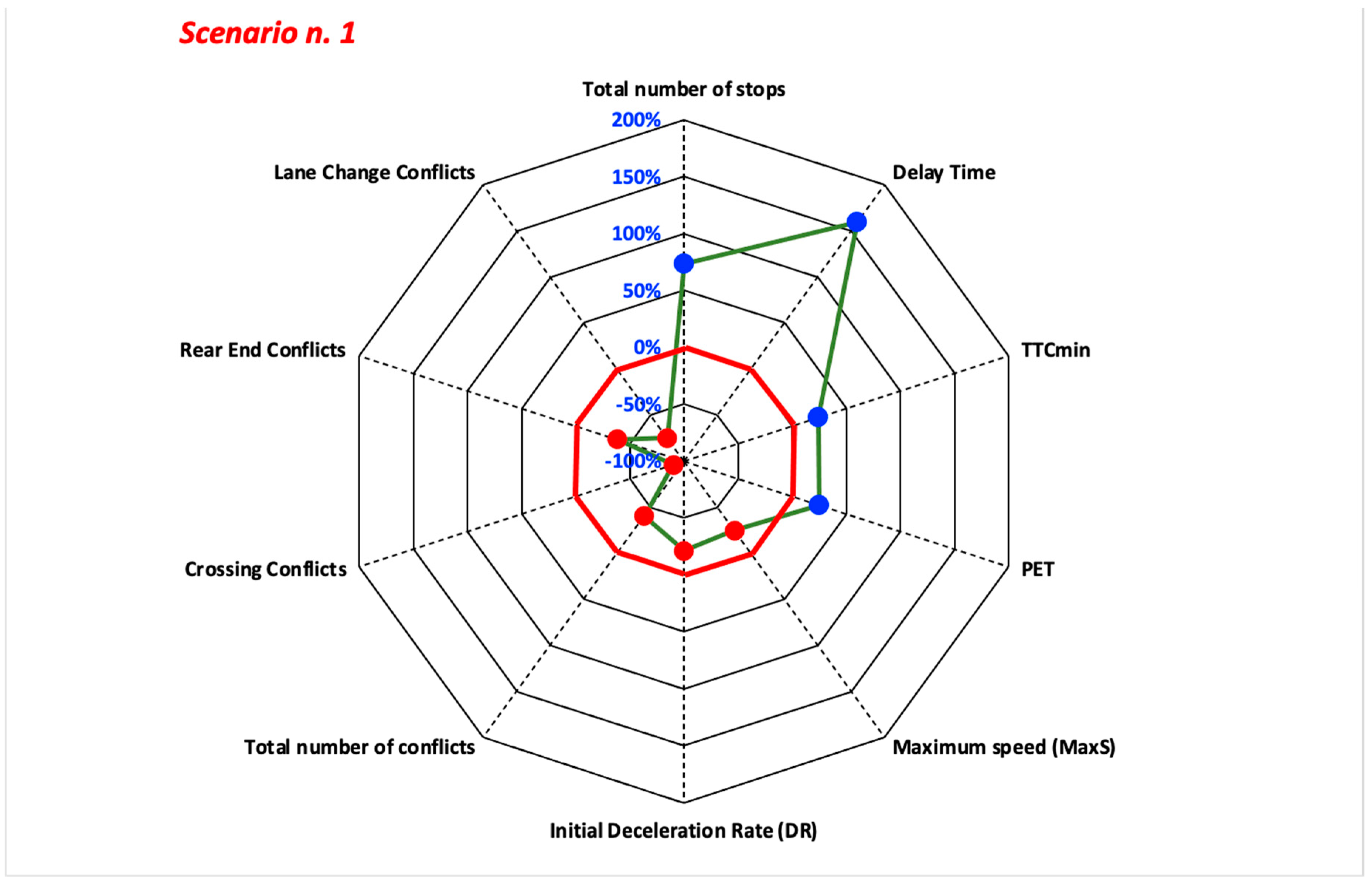
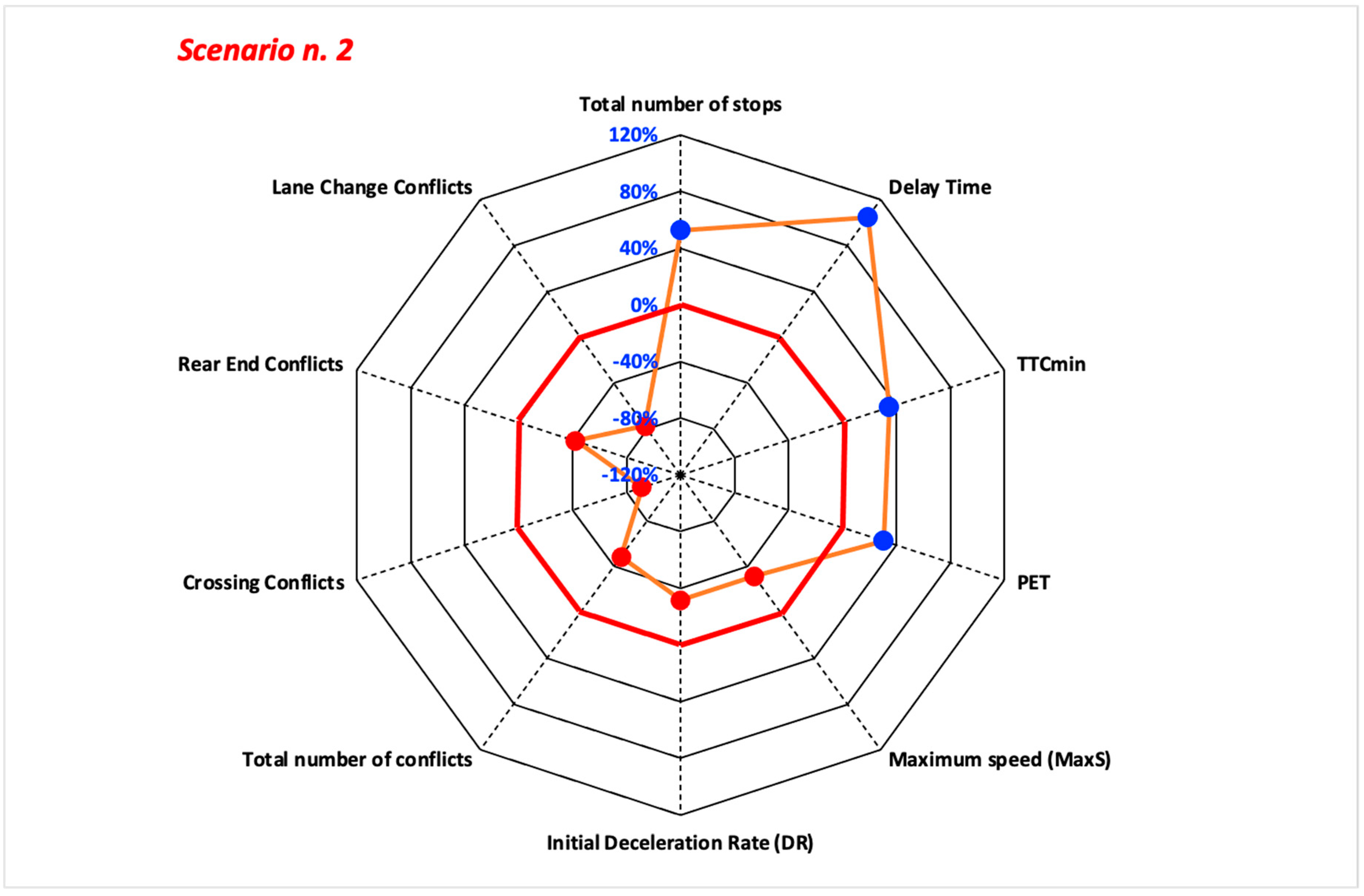
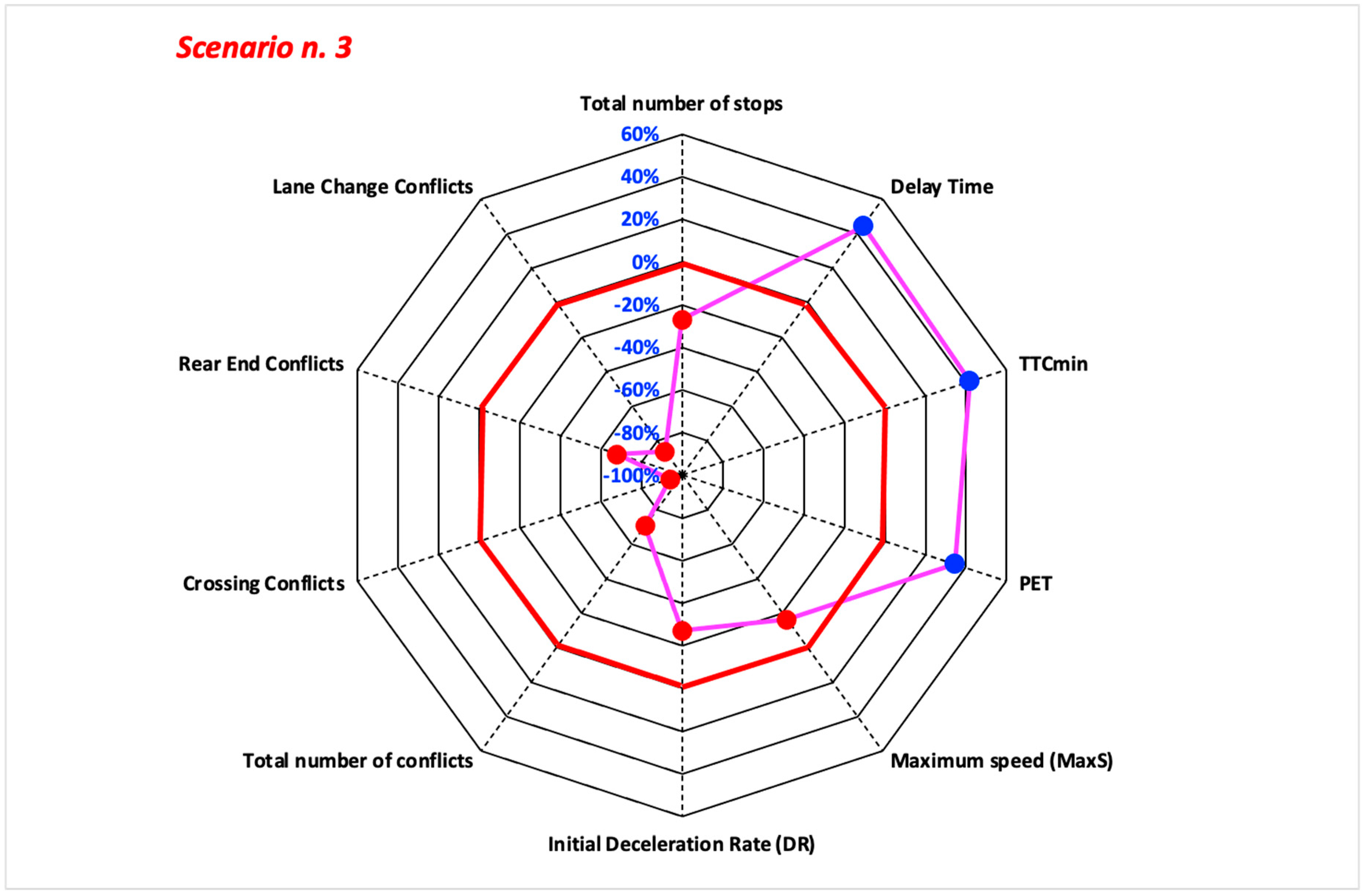
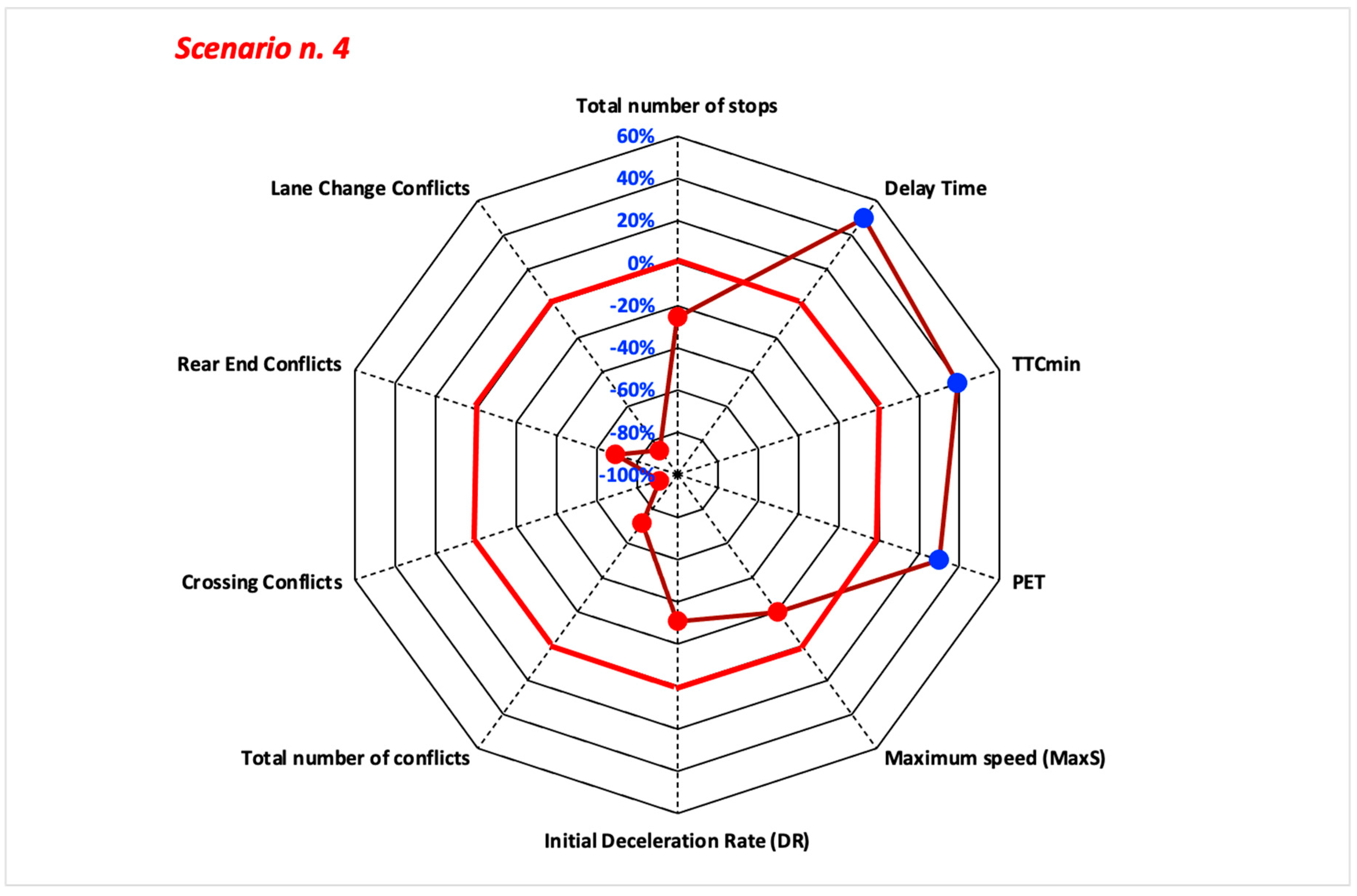
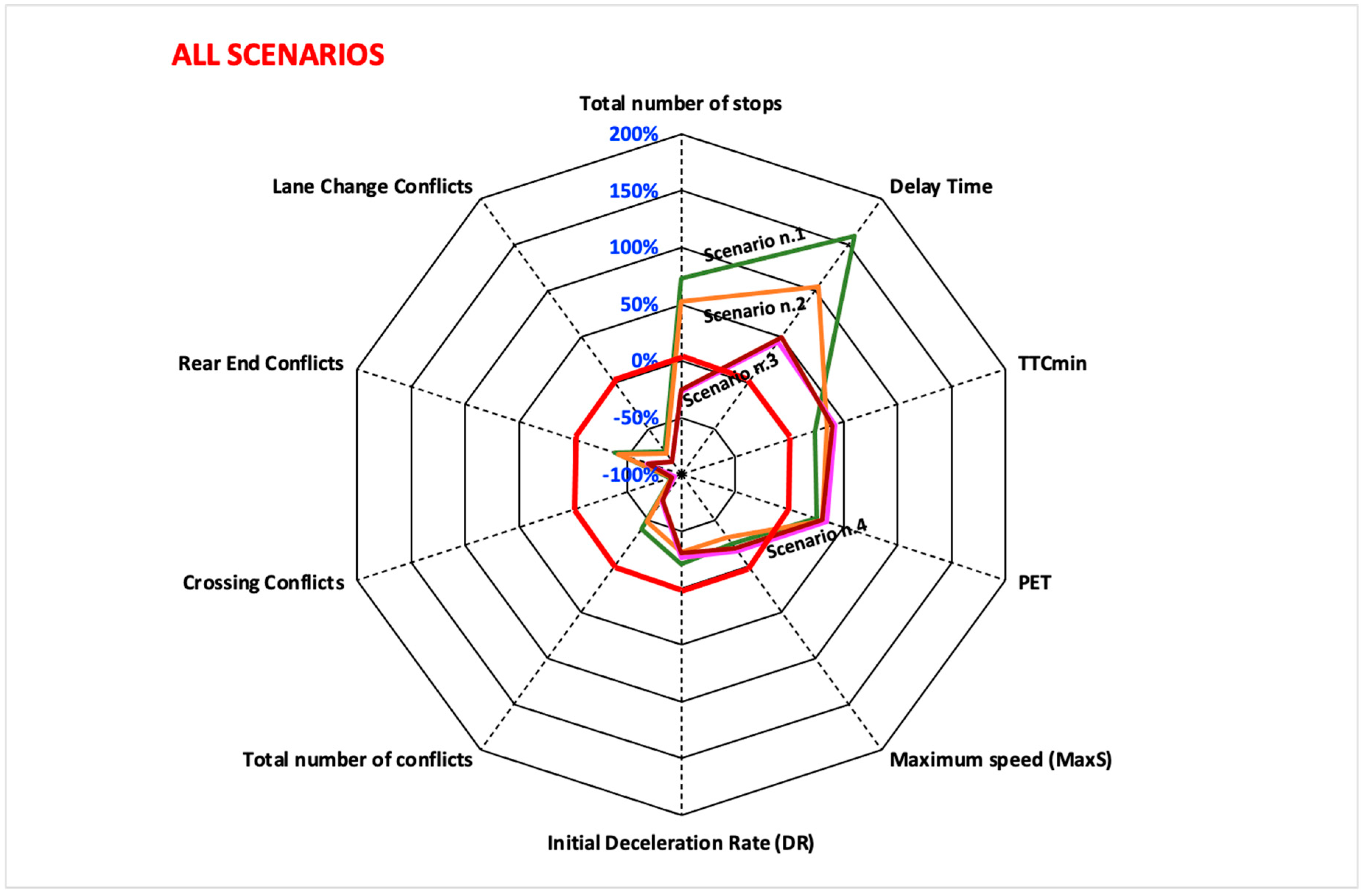
| VISSIM | AIMSUN Next | PARAMICS | TRITONE | |
|---|---|---|---|---|
| Advantages | ||||
| User-defined algorithms for vehicle movement control. | X | X | ||
| Appropriate for traffic simulation, traffic data analysis, planning, etc. | X | X | X | X |
| Intersection type is not predefined. | X | |||
| The duration of traffic analysis can be defined by the user. | X | |||
| Includes psycho-physical model for car-following. | ||||
| Includes car-following models and other calibration methods. | X | |||
| Suitable for safety analysis based on vehicle trajectory. | X | X | X | |
| Disadvantages | ||||
| Developing a complete algorithm for safety analysis is difficult, especially for new users | X | |||
| There are few options for modeling accidents. | X | |||
| Coding the inputs and outputs is very time consuming and labor intensive. | X | X | ||
| The modeled trajectories are not realistic. | X | |||
| Traffic volume is determined using origin-destination matrices. | X |
| Type of Turbo-Roundabout | ||||
|---|---|---|---|---|
| Design parameter | Mini | Standard | Medium | Large |
| R1 | 10.45 m | 12.00 m | 14.95 m | 19.95 m |
| R2 | 15.85 m | 17.15 m | 20.00 m | 24.90 m |
| R3 | 16.15 m | 17.45 m | 20.30 m | 25.20 m |
| R4 | 21.20 m | 22.45 m | 25.25 m | 29.95 m |
| r1 | 10.95 m | 12.50 m | 15.45 m | 20.45 m |
| r2 | 15.65 m | 16.95 m | 19.80 m | 24.70 m |
| r3 | 16.35 m | 17.65 m | 20.50 m | 25.40 m |
| r4 | 20.70 m | 21.95 m | 24.75 m | 29.45 m |
| Ds | 0.30 m | 0.30 m | 0.30 m | 0.30 m |
| ds | 0.70 m | 0.70 m | 0.70 m | 0.70 m |
| Bi | 5.40 m | 5.15 m | 5.05 m | 4.95 m |
| Be | 5.05 m | 5.00 m | 4.95 m | 4.75 m |
| bi | 4.70 m | 4.45 m | 4.35 m | 4.25 m |
| be | 4.35 m | 4.30 m | 4.25 m | 4.05 m |
| Dv | 5.75 m | 5.30 m | 5.15 m | 5.15 m |
| Du | 5.05 m | 5.00 m | 4.95 m | 4.75 m |
| Total Number of Stops | Delay Time [s/km] | TTCmin [s] | PET [s] | Maximum Speed (MaxS) [m/s] | Initial Deceleration Rate (DR) [m/s2] | Total Number of Conflicts | Crossing Conflicts | Rear End Conflicts | Lane Change Conflicts | |
|---|---|---|---|---|---|---|---|---|---|---|
| Scenario n. 1 | 1113 | 24.75 | 0.93 | 1.85 | 6.44 | 2.84 | 3364 | 10 | 2911 | 443 |
| Scenario n. 2 | 1313 | 35.89 | 0.91 | 1.91 | 5.82 | 2.87 | 4699 | 23 | 3982 | 694 |
| Scenario n. 3 | 2819 | 74.34 | 0.88 | 1.84 | 4.67 | 2.51 | 9028 | 34 | 7783 | 1211 |
| Scenario n. 4 | 3176 | 91.40 | 0.89 | 1.87 | 4.57 | 2.50 | 9683 | 45 | 8360 | 1278 |
| Total Number of Stops | Delay Time [s/km] | TTCmin [s] | PET [s] | Maximum Speed (MaxS) [m/s] | Initial Deceleration Rate (DR) [m/s2] | Total Number of Conflicts | Crossing Conflicts | Rear End Conflicts | Lane Change Conflicts | |
|---|---|---|---|---|---|---|---|---|---|---|
| Scenario n. 1 | 1926 | 64.16 | 1.15 | 2.31 | 4.86 | 2.24 | 2009 | 1 | 1798 | 112 |
| Scenario n. 2 | 1999 | 73.44 | 1.23 | 2.49 | 3.98 | 1.96 | 2417 | 2 | 2310 | 156 |
| Scenario n. 3 | 2056 | 107.44 | 1.25 | 2.47 | 3.82 | 1.83 | 2659 | 2 | 2490 | 167 |
| Scenario n. 4 | 2368 | 136.92 | 1.24 | 2.43 | 3.74 | 1.73 | 2741 | 4 | 2567 | 183 |
Disclaimer/Publisher’s Note: The statements, opinions and data contained in all publications are solely those of the individual author(s) and contributor(s) and not of MDPI and/or the editor(s). MDPI and/or the editor(s) disclaim responsibility for any injury to people or property resulting from any ideas, methods, instructions or products referred to in the content. |
© 2023 by the authors. Licensee MDPI, Basel, Switzerland. This article is an open access article distributed under the terms and conditions of the Creative Commons Attribution (CC BY) license (https://creativecommons.org/licenses/by/4.0/).
Share and Cite
Leonardi, S.; Distefano, N. Turbo-Roundabouts as an Instrument for Improving the Efficiency and Safety in Urban Area: An Italian Case Study. Sustainability 2023, 15, 3223. https://doi.org/10.3390/su15043223
Leonardi S, Distefano N. Turbo-Roundabouts as an Instrument for Improving the Efficiency and Safety in Urban Area: An Italian Case Study. Sustainability. 2023; 15(4):3223. https://doi.org/10.3390/su15043223
Chicago/Turabian StyleLeonardi, Salvatore, and Natalia Distefano. 2023. "Turbo-Roundabouts as an Instrument for Improving the Efficiency and Safety in Urban Area: An Italian Case Study" Sustainability 15, no. 4: 3223. https://doi.org/10.3390/su15043223





